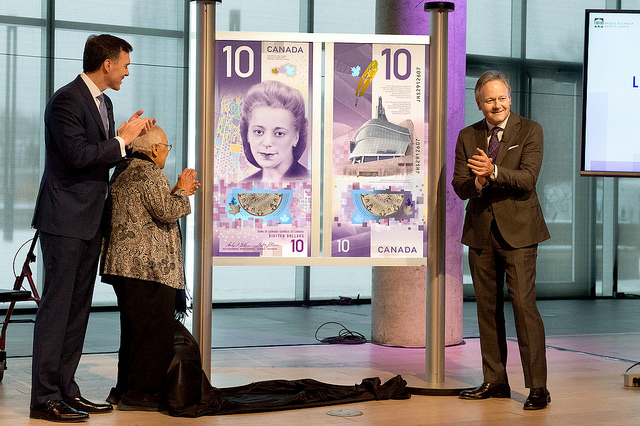
Canadian hero Viola Desmond is the face on the new $10 bill in Canada, which goes into circulation at the end of March.
Viola Desmond was thrown in jail in Nova Scotia in 1946 because, in a movie theatre, she wanted to sit downstairs where the white people were allowed to sit. She didn’t want to sit up in the balcony, where the black people had to sit. The police held her in jail overnight. The dignified and brave Desmond paid a fine of $20 the next day, even though she had done nothing wrong. Today, we think of her for being a brave advocate for the rights of African-Canadians and helping to inspire the human rights movement in Canada.
(Learn more about Desmond on Historica Canada’s Viola Desmond page.)
It is a great honour to have your face on a country’s money. This is the first time an African-Canadian woman has been featured on Canadian paper money. (Queen Elizabeth is featured on the $20 bill.)
There’s something else interesting about the new bill. For the first time, it is vertical, meaning it’s meant to be looked at up-and-down rather than horizontally (across).
The new bill also features a number of images that are reminders of human rights. For instance, there is an image of the Canadian Museum for Human Rights, in Winnipeg, Manitoba, where Desmond’s story is part of the permanent collection. There is an image of a feather, to recognize rights and freedoms for Canada’s Indigenous Peoples. And it features a paragraph from the Canadian Charter of Rights and Freedoms (section 15, which says, “Every individual is equal before and under the law.”
Viola Desmond’s sister, Wanda Robson, was one of the first people in Canada to receive a copy of the new $10 bill. In a Bank of Canada video (below), she said her sister’s photo on it is “so life-like. It’s as if she’s in this room!”
Related Videos
The video below (1:00) is a “Heritage Minute” produced by Historica Canada. It tells the story of Viola Desmond.
Watch as Viola Desmond’s sister, Wanda Robson, gets to see the new $10 for the first time. YouTube video (1:25)
Related Links
UPDATE: The Bank of Canada has provided us with a Q&A about the bank note process. It contains some fascinating details.
There’s a hidden game on the Bank of Canada website, that you can play on your computer. On this page: https://www.bankofcanada.ca/banknotes/vertical10/ click on the “SPIN” button underneath the 3D image of the $10 bill. When you’ve spun it 20 times, a game called “Bank of Canada Inflation Busters” (similar to Space Invaders) will automatically come up–and you can play it using the Space bar and direction keys on your computer.
Here’s a good article on CBC News that talks more about this “Easter egg” (another way to refer to a hidden feature on a website) and another Easter egg the Bank of Canada hid on its website last year. http://www.cbc.ca/news/politics/bank-of-canada-space-invaders-1.4568623

Bank of Canada – Bank Notes web page: https://www.bankofcanada.ca/banknotes/?page_moved=1
Some great information about the history of money in Canada, and its future (for instance, bitcoin): http://www.thecanadianencyclopedia.ca/en/article/money/
CURRICULUM CONNECTIONS
By Jonathan Tilly
Writing/Discussion Prompt
Make a list of four Canadians who you think should be honoured on a bank note. Narrow down your list to 2 choices. Make a list of pros and cons for each figure.
If participating as a class, nominate several influential Canadians and hold a short debate, highlighting significance, contribution, and who they represent. Conclude your discussion with a vote.
Reading Prompt: Extending Understanding
The Canadian Charter of Rights and Freedoms says, “Every individual is equal before and under the law.” A few weeks ago, Canada changed a lyric in its anthem: “In all thy sons command,” was changed to, “In all of us command.”
Compare and contrast these articles by asking what do they have in common? What makes them different? How do these articles contribute to your understanding of what it means to be Canadian?
Primary
Extend understanding of texts by connecting the ideas in them to their own knowledge and experience, to other familiar texts, and to the world around them (OME, Reading: 1.6).
Junior
Extend understanding of texts by connecting the ideas in them to their own knowledge, experience, and insights, to other familiar texts, and to the world around them (OME, Reading: 1.6).
Intermediate
Extend understanding of texts, including increasingly complex or difficult texts, by connecting the ideas in them to their own knowledge, experience, and insights, to other familiar texts, and to the world around them (OME, Reading: 1.6).
Language Feature: Reading Unfamiliar Words
The first line of today’s article is:
Canadian hero Viola Desmond is the face on the new $10 bill in Canada, which goes into circulation at the end of March [italics added].
The root of the word “circulation” is closely related to “circle.” How does this inform or add to the meaning of “circulation.” How can identifying base words help readers understand unfamiliar words?
Primary, Junior, and Intermediate
Predict the meaning of and rapidly solve unfamiliar words using different types of cues, including: semantic (meaning) cues (e.g., prefixes, suffixes, base words, phrases, sentences, and visuals that activate existing knowledge of oral and written language) (OME, Reading: 3.2).







